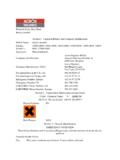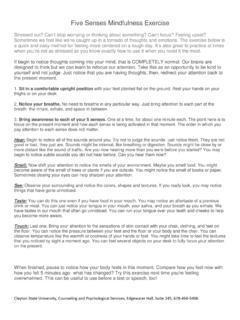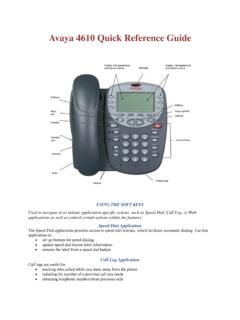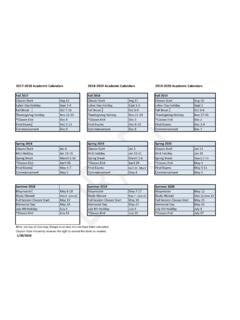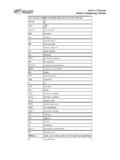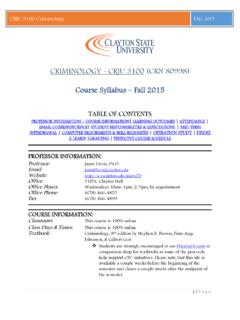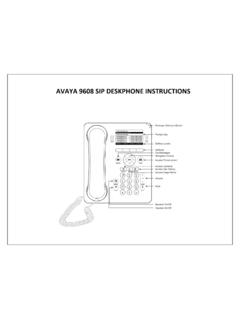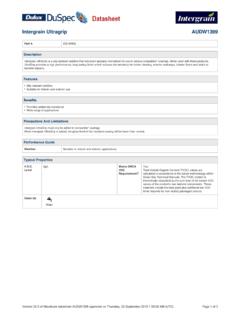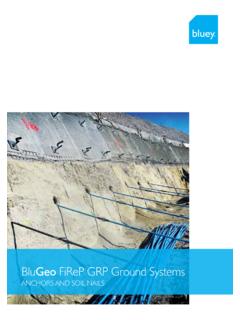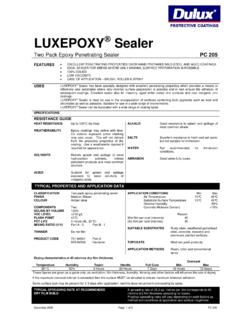Transcription of Material Safety Data Sheet - Clayton State University
1 Material Safety data Sheet Paraffin wax MSDS# 88655 Section 1 - Chemical Product and Company Identification MSDS Name: Paraffin wax Catalog Numbers: C/2700/99, P/0500/90, P/0560/90, P/0600/90, P/0650/90, P/0680/90, P/0720/90 Synonyms: Paraffin waxes and hydrocarbon waxes.
2 It consists predominantly of straight chain hydrocarbons having carbon numbers predominantly greater than C20. Company Identification:Fisher Scientific UK Bishop Meadow Road, Loughborough Leics. LE11 5RG For information in Europe, call:(01509) 231166 Emergency Number, Europe: 01509 231166 Section 2 - Composition, Information on Ingredients ---------------------------------------- CAS#: 8002-74-2 Chemical Name: Paraffin waxes and hydrocarbon waxes %.
3 100 EINECS#: 232-315-6 ---------------------------------------- Hazard Symbols: None listed Risk Phrases: None listed Section 3 - Hazards Identification EMERGENCY OVERVIEW Not available Potential Health Effects Eye: Vapors may cause eye irritation.
4 Skin: Low hazard for usual industrial handling. Contact with heated Material can cause skin burns and irritation. Ingestion: May cause irritation of the digestive tract. Inhalation: Inhalation of a mist of this Material may cause respiratory tract irritation. Chronic: Prolonged or repeated skin contact may cause dermatitis.
5 Section 4 - First Aid Measures Eyes: Immediately flush eyes with plenty of water for at least 15 minutes, occasionally lifting the upper and lower eyelids. Get medical aid. Skin: Get medical aid if irritation develops or persists. Flush skin with plenty of soap and water. Ingestion: If victim is conscious and alert, give 2-4 cupfuls of milk or water.
6 Get medical aid. Inhalation: Remove from exposure and move to fresh air immediately. If not breathing, give artificial respiration. If breathing is difficult, give oxygen. Get medical aid. Notes to Physician: Section 5 - Fire Fighting Measures General Information: As in any fire, wear a self-contained breathing apparatus in pressure-demand, MSHA/NIOSH (approved or equivalent), and full protective gear.
7 During a fire, irritating and highly toxic gases may be generated by thermal decomposition or combustion. Extinguishing Media: Use water spray, dry chemical, carbon dioxide, or chemical foam. Section 6 - Accidental Release Measures General Information: Use proper personal protective equipment as indicated in Section 8. Spills/Leaks: Sweep up, then place into a suitable container for disposal.
8 Section 7 - Handling and Storage Handling: Wash thoroughly after handling. Wash thoroughly after handling. Storage: Keep away from heat and flame. Store in a cool, dry place. Section 8 - Exposure Controls, Personal Protection Engineering Controls: Good general ventilation should be sufficient to control airborne levels. Exposure Limits CAS# 8002-74-2: United Kingdom, WEL - TWA: 2 mg/m3 TWA (fume) United Kingdom, WEL - STEL: 6 mg/m3 STEL (fume) Belgium - TWA: 2 mg/m3 VLE (fume) France - VME: 2 mg/m3 VME (fume) Malaysia: 2 mg/m3 TWA (fume) Spain.
9 2 mg/m3 VLA-ED Personal Protective Equipment Eyes: Wear Safety glasses and chemical goggles if handling molten Material . Skin: Wear heat resistant gloves, apron, and/or clothing for the handling of molten materials. Clothing: Wear heat resistant gloves, apron, and/or clothing for the handling of molten materials.
10 Respirators: Follow the OSHA respirator regulations found in 29 CFR or European Standard EN 149. Use a NIOSH/MSHA or European Standard EN 149 approved respirator if exposure limits are exceeded or if irritation or other symptoms are experienced. Section 9 - Physical and Chemical Properties Physical State : Solid Color: white to yellow Odor: Not available pH: Not available Vapor Pressure: Not available Viscosity: Not available Boiling Point: > 370 deg C (> F) Freezing/Melting Point.
